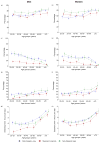Measurement of adults' sedentary time in population-based studies
- PMID: 21767730
- PMCID: PMC3179387
- DOI: 10.1016/j.amepre.2011.05.005
Measurement of adults' sedentary time in population-based studies
Abstract
Sedentary time (too much sitting) increasingly is being recognized as a distinct health risk behavior. This paper reviews the reliability and validity of self-reported and device-based sedentary time measures and provides recommendations for their use in population-based studies. The focus is on instruments that have been used in free-living, population-based research in adults. Data from the 2003-2006 National Health and Nutrition Examination Survey are utilized to compare the descriptive epidemiology of sedentary time that arises from the use of different sedentary time measures. A key recommendation from this review is that, wherever possible, population-based monitoring of sedentary time should incorporate both self-reported measures (to capture important domain- and behavior-specific sedentary time information) and device-based measures (to measure both total sedentary time and patterns of sedentary time accumulation).
Copyright © 2011 American Journal of Preventive Medicine. All rights reserved.
Figures




References
-
- Ainsworth BE, Haskell WL, Whitt MC, Irwin ML, Swartz AM, Strath SJ, et al. Compendium of physical activities: an update of activity codes and MET intensities. Med Sci Sports Exerc. 2000;32(9 Suppl):S498–504. - PubMed
-
- Clark BK, Sugiyama T, Healy GN, Salmon J, Dunstan DW, Owen N. Validity and reliability of measures of television viewing time and other non-occupational sedentary behaviour of adults: a review. Obes Rev. 2009;10(1):7–16. - PubMed
-
- Sallis JF, Saelens BE. Assessment of physical activity by self-report: status, limitations, and future directions. Res Q Exerc Sport. 2000;71(2 Suppl):S1–14. - PubMed
-
- Klesges RC, Eck LH, Mellon MW, Fulliton W, Somes GW, Hanson CL. The accuracy of self-reports of physical activity. Med Sci Sports Exerc. 1990;22(5):690–697. - PubMed
Publication types
MeSH terms
Grants and funding
LinkOut - more resources
Full Text Sources
Medical

